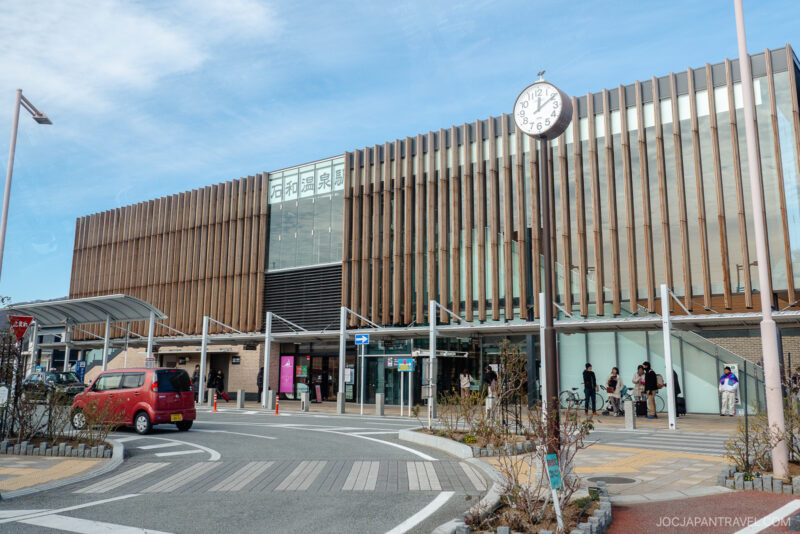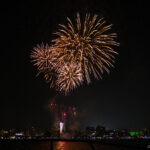This post may contain affiliate links. Please read our disclosure policy.
Celebrate Japan’s most important holiday at Isawa Onsen, where soothing hot springs, festive meals, and cultural traditions create an unforgettable New Year experience.

Why Celebrating New Year in Japan Requires Planning
Japan’s New Year holiday (Oshogatsu) is the most important celebration of the year, and it’s also one of the busiest travel periods. We learned that planning ahead is essential:
- Book transportation early: Trains and flights sell out quickly. We reserved our tickets more than two months in advance.
- Choose meal-inclusive plans: Some ryokan offer room-only stays unless you specifically book a plan with meals.
- Expect closures: On January 1, many restaurants and shops are closed. Some reopen on January 3 or later.
- Budget for higher rates: Hotels usually charge significantly more—sometimes double—during holidays.
Why We Chose Isawa Onsen (石和温泉)

Just two hours from Tokyo, Isawa Onsen is one of Yamanashi Prefecture’s best-kept secrets. Unlike Hakone or Kusatsu, it’s less crowded and offers a convenient blend of city comforts and traditional hot spring culture. The hot springs were discovered in 1961, making it a relatively new resort town, but its central location in Fuefuki City (笛吹市) gave us easy access to local shops and food.
Exploring Fuefuki Before the Countdown

We arrived at Isawa Onsen Station on New Year’s Eve around noon and had time to explore before check-in. Many businesses were already closing for the holiday, so we stopped for lunch at Rocks, a French-Italian restaurant. The food was fine, but what caught our attention was the owner’s impressive guitar collection.
Fuefuki is also known for its fruits—grapes, peaches, and plums—and the shops reflected this, selling fruit-based sweets, local wines, and unique souvenirs. We’ve visited in the summer for fruit picking and outdoor activities, and highly recommend it.
Hotel Sekifu Isawa Onsen

First Impressions
A last-minute booking change brought us to Hotel Sekifu (ホテル石風), which turned out to be a great surprise. The lobby had a retro 1980s charm with chandeliers, blue velvet chairs, and golden accents.
Our ryokan-style room featured tatami mats, sliding shoji doors, and festive decorations like kagami mochi and fresh flowers. Outside, the Japanese garden and koi pond were beautiful spots to stroll.
The New Year’s Eve Feast

For the holiday night, we upgraded our meal plan and enjoyed a grand feast of lobster, king crab, and abalone. It wasn’t a refined kaiseki presentation, but the abundance and variety made the dinner memorable.
Soaking and Celebrating
After dinner, we soaked in the onsen baths, then played Uno and Jenga with the kids and grandparents. Later, we gathered around the TV for the annual NHK New Year’s Eve program, Kohaku Uta Gassen.
Just after midnight, we walked to a nearby shrine for hatsumode, joining locals in praying for good health and a hopeful year ahead.
What to Expect at a Japanese Onsen During New Year
- Hotel prices can be 50–100% higher than usual.
- Seasonal decorations like kadomatsu (bamboo and pine) adorn entrances.
- Quiet streets after midnight, as families head to shrines instead of public countdowns.
- Hatsumode, the first shrine visit of the year, is an important local tradition.
Welcoming the New Year

New Year’s Day started with a stunning sunrise over the mountains, best enjoyed from the comfort of the baths. Breakfast featured osechi ryori, with traditional dishes like datemaki and tazukuri, followed by complimentary sake served in the lobby.
How to Get to Isawa Onsen (石和温泉)
Train
From Shinjuku Station, ride the JR Chuo Line Limited Express Azusa or Kaiji to Isawa Onsen Station. The trip takes about 90 to 120 minutes. Reserve seats for holiday travel.
- Most trains are direct. Check the final destination before boarding.
- Trains run less frequently late at night and on New Year’s Day.
- There is a taxi stand at the station for short rides to ryokan.
Car
Drive the Chuo Expressway from Tokyo toward Kofu. Exit at Ichinomiya-Misaka and follow signs to Fuefuki City. The drive takes about 90 minutes without traffic.
- Winter roads can be icy. Carry snow tires or chains if needed.
Pro Tip: Traveling December 31 to January 3? Book round-trip reserved seats, confirm your ryokan’s shuttle or taxi plan, and arrive with snacks since many shops close early.
Is Isawa Onsen Worth Visiting During New Year?
Isawa Onsen may not be as famous as Hakone, but its convenient location, family-friendly ryokan, and welcoming New Year traditions make it a wonderful choice.
We loved how it balanced relaxation with cultural experiences, and the proximity to Tokyo makes it a practical option for families who want to celebrate Oshogatsu in a memorable way.
More to Explore Nearby
Isawa Onsen is one of Yamanashi Prefecture’s major hot spring towns, positioning you near breathtaking views of Mount Fuji, unique agricultural experiences, and exciting recreational activities.
- Fruit Picking and Wine Tasting – Explore the surrounding region’s famous vineyards and orchards, offering seasonal fruit picking and local wine tasting experiences.
- Fuefuki City Isawa Onsen – Discover more details about the local region and its attractions, which center around the hot spring area.
- Mount Fuji Panoramic Ropeway – Head to Lake Kawaguchi for a scenic gondola ride that offers stunning, iconic views of Mount Fuji.
- Fuji-Q Highland Amusement Park – Experience the thrilling roller coasters and major attractions at this popular theme park located near the base of Mount Fuji.




